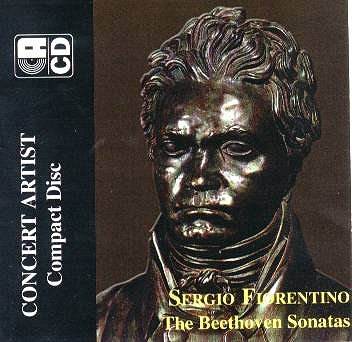There are now six volumes of Sergio Fiorentino’s Beethoven
Sonatas in Concert Artist/Fidelio’s catalogue. Those in this, the second
volume, cover the years 1961-66 and feature much distinguished playing,
with considerable seriousness and characterisation as well as rhythmic
acuity. In the A flat Sonata, Op. 26 for example Fiorentino vests the
opening Andante con variazioni with simplicity whilst not being afraid
to exploit the tied bass in the variational section to inflect a greater
and increasing sense of depth. It is quite possible to imagine pianists
who treat the following Scherzo as an opportunity for fingerwork display
but not Fiorentino. True he is propulsive but he is always clear; yes,
there is animation and drive but equally he extracts real lyrical charm
from the trio and there is no hardening of tone (it remains perfectly
rounded). Propulsion is never at the expense of a just tempo. In the
Funeral March on the Death of a Hero Fiorentino is careful to keep the
death rhythm in the left hand coursing through the length of the movement
and in the finale, a brisk Allegro, he is delightfully forthright.
The E flat sonata, an opus companion of the Moonlight,
illustrates how perceptively Fiorentino uses internal contrastive
material to propel a movement. The lullaby nature of the initial material
and the depth of left hand sonority he extracts is well contrasted with
the ensuing Allegro. Similarly whilst he is frequently eruptive and
tempestuous in the Allegro molto e vivace this never becomes over-scaled
playing. The little Andante seems in his hands almost to play itself,
so self-effacingly right does his approach appear, whilst in the finale
Fiorentino’s voicings are apt and alert and well-balanced, the clarity
of his fingerwork notable, his instinct for driving and purposeful direction.
He can also bring out the delicate nostalgia that often lurks within
this work with felicitous imagination. The Pastoral, the D major
is another fine reading. He brings out the ceaseless almost informal
flux of the opening Allegro; themes emerge with naturalism and Fiorentino
studiously reduces his dynamics, terracing them with skill, from 5.40.
In the Andante the ostinati are actively propelled, motifs delineated
with care, bass and treble sonorities maintained. His right hand is
full of suggestive clarity. The rhythmic virility of the Scherzo is
matched by the finale, which manages to remain passionate, but at a
reasonable tempo still reflectively charming. He catches its essence
with real acumen and insight.
These are strong and persuasive performances, reflecting
Fiorentino’s laudable qualities as a Beethovenian. The world hardly
lacks for sonata recitals or cycles of the 32 (Fiorentino never got
around to recording them all for Concert Artist/Fidelio) but this is
nevertheless, and irrespective of other considerations, a notable disc.
Jonathan Woolf
